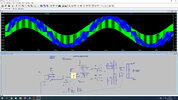Hi,
Is the attached OK to take forward as a Grid Tied Inverter design?
As you know, it still needs all the protections to be added.
It shovels a sinusoid current into the mains.
LTspice sim and pdf schem attached.
Is the attached OK to take forward as a Grid Tied Inverter design?
As you know, it still needs all the protections to be added.
It shovels a sinusoid current into the mains.
LTspice sim and pdf schem attached.



